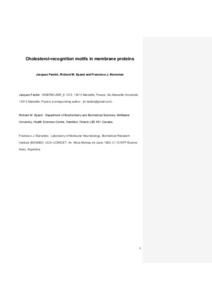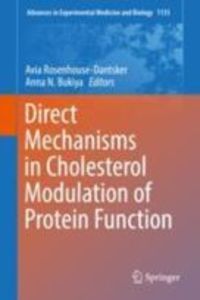Por favor, use este identificador para citar o enlazar este ítem:
https://repositorio.uca.edu.ar/handle/123456789/9017| Campo DC | Valor | Lengua/Idioma |
|---|---|---|
| dc.contributor.author | Barrantes, Francisco José | es |
| dc.contributor.author | Fantini, Jacques | es |
| dc.contributor.author | Epand, Richard M. | es |
| dc.date.accessioned | 2019-11-12T14:30:00Z | - |
| dc.date.available | 2019-11-12T14:30:00Z | - |
| dc.date.issued | 2019 | - |
| dc.identifier.citation | Fantini J., Epand R.M., Barrantes F.J. Cholesterol-recognition motifs in membrane proteins [en línea]. Postprint del capítulo publicado en Rosenhouse-Dantsker A., Bukiya A. (eds). Advances in experimental medicine and biology, vol 1135. Springer, Cham, 2019. doi: 10.1007/978-3-030-14265-0_1. Disponible en: https://repositorio.uca.edu.ar/handle/123456789/9017 | es |
| dc.identifier.isbn | 978-3-030-14264-3 | - |
| dc.identifier.isbn | 978-3-030-14265-0 (online) | - |
| dc.identifier.uri | https://repositorio.uca.edu.ar/handle/123456789/9017 | - |
| dc.description.abstract | Abstract: The impact of cholesterol on the structure and function of membrane proteins was recognized several decades ago, but the molecular mechanisms underlying these effects have remained elusive. There appear to be multiple mechanisms by which cholesterol interacts with proteins. A complete understanding of cholesterol-sensing motifs is still undergoing refinement. Initially, cholesterol was thought to exert only non-specific effects on membrane fluidity. It was later shown that this lipid could specifically interact with membrane proteins and affect both their structure and function. In this article, we have summarized and critically analyzed our evolving understanding of the affinity, specificity and stereoselectivity of the interactions of cholesterol with membrane proteins. We review the different computational approaches that are currently used to identify cholesterol binding sites in membrane proteins and the biochemical logic that governs each type of site, including CRAC, CARC, SSD and amphipathic helix motifs. There are physiological implications of these cholesterol-recognition motifs for G-protein coupled receptors (GPCR) and ion channels, in membrane trafficking and membrane fusion (SNARE) proteins. There are also pathological implications of cholesterol binding to proteins involved in neurological disorders (Alzheimer, Parkinson, Creutzfeldt-Jakob) and HIV fusion. In each case, our discussion is focused on the key molecular aspects of the cholesterol and amino acid motifs in membrane-embedded regions of membrane proteins that define the physiologically relevant crosstalk between the two. Our understanding of the factors that determine if these motifs are functional in cholesterol binding will allow us enhanced predictive capabilities. | es |
| dc.format | application/pdf | es |
| dc.language.iso | eng | es |
| dc.publisher | Springer, Cham | es |
| dc.rights | Acceso abierto. 2 años de embargo | * |
| dc.rights.uri | http://creativecommons.org/licenses/by-nc-sa/4.0/ | * |
| dc.source | Postprint del capítulo publicado en Rosenhouse-Dantsker A., Bukiya A. (eds). Advances in experimental medicine and biology, vol 1135, 2019 | es |
| dc.subject | COLESTEROL | es |
| dc.subject | PROTEINAS | es |
| dc.subject | ENFERMEDADES DEL SISTEMA NERVIOSO | es |
| dc.subject | MEMBRANAS CELULARES | es |
| dc.title | Cholesterol-recognition motifs in membrane proteins | es |
| dc.type | Parte de libro | es |
| dc.identifier.doi | 10.1007/978-3-030-14265-0_1 | - |
| uca.disciplina | MEDICINA | es |
| uca.issnrd | 1 | es |
| uca.affiliation | Fil: Barrantes, Francisco José. Pontificia Universidad Católica Argentina. Facultad de Ciencias Médicas. Instituto de Investigaciones Biomédicas. Laboratorio de Neurobiología Molecular; Argentina | es |
| uca.affiliation | Fil: Barrantes, Francisco José. Consejo Nacional de Investigaciones Científicas y Técnicas; Argentina | es |
| uca.affiliation | Fil: Fantini, Jacques. Aix-Marseille Université; Francia | es |
| uca.affiliation | Fil: Epand, Richard M. McMaster University. Department of Biochemistry and Biomedical Sciences; Canadá | es |
| uca.affiliation | Fil: Epand, Richard M. Health Sciences Centre; Canadá | es |
| uca.version | acceptedVersion | es |
| item.languageiso639-1 | en | - |
| item.grantfulltext | open | - |
| item.fulltext | With Fulltext | - |
| crisitem.author.dept | Instituto de Investigaciones Biomédicas - BIOMED | - |
| crisitem.author.dept | Laboratorio de Neurobiología Molecular | - |
| crisitem.author.dept | Facultad de Ciencias Médicas | - |
| crisitem.author.orcid | 0000-0002-4745-681X | - |
| crisitem.author.parentorg | Facultad de Ciencias Médicas | - |
| crisitem.author.parentorg | Instituto de Investigaciones Biomédicas - BIOMED | - |
| crisitem.author.parentorg | Pontificia Universidad Católica Argentina | - |
| Aparece en las colecciones: | Libros o partes de libro | |
Ficheros en este ítem:
| Fichero | Descripción | Tamaño | Formato | |
|---|---|---|---|---|
| cholesterol-recognition-motifs-membrane.pdf | 1,27 MB | Adobe PDF |  Visualizar/Abrir | |
| cholesterol-recognition-motifs-membrane.jpg | 5,34 kB | JPEG |  Visualizar/Abrir |
Este ítem está sujeto a una Licencia Creative Commons

